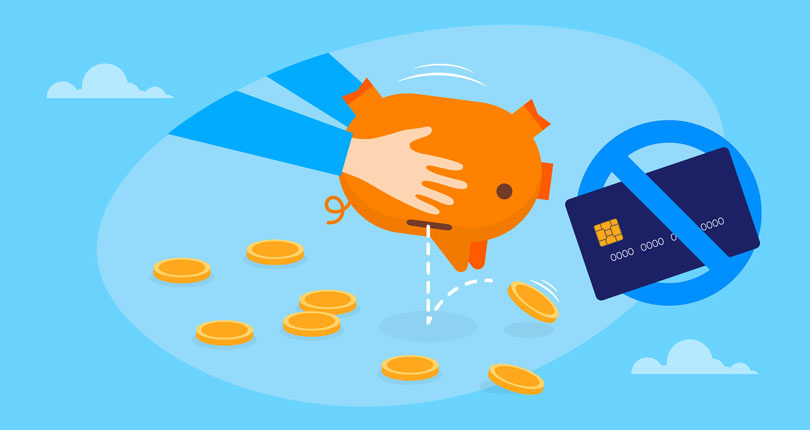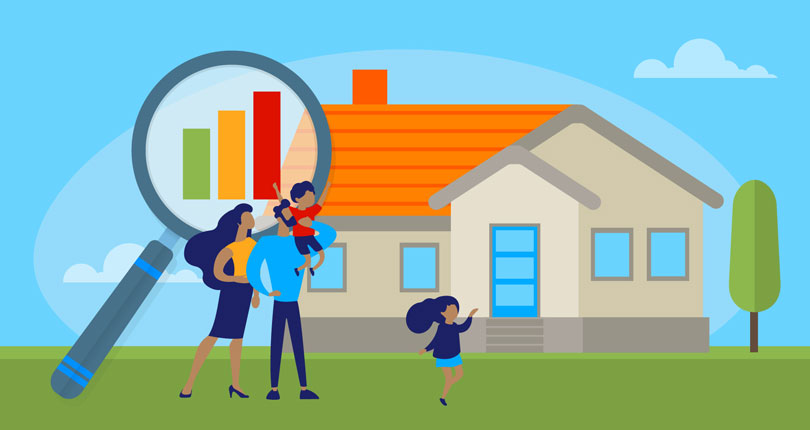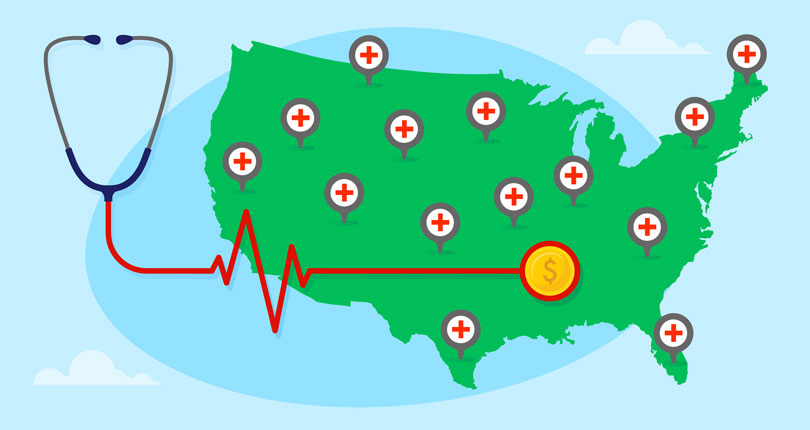The Unbanked and Underbanked Population

The unbanked and underbanked population in the U.S. is a group of people who have either no bank account at all or are regularly using alternatives to banks to manage their finances.
But why do some people not have a bank account, and which demographics are the most likely to fall into the category of unbanked or underbanked? This analysis looks into statistics on people who don’t have or use a bank account, and how this could affect them.
Key statistics
- The Federal Reserve found that in the U.S., 13% of adults are underbanked as of 2021, meaning they have a bank account but regularly use alternative financial services, and 5% are unbanked meaning they have no bank account at all.
- The unbanked population is made up of around 13 million people in the U.S.
- In terms of race, Black people are more likely to be part of this population, with 11.3% being unbanked and 24.7% being underbanked. In comparison, 2.1% of white people are unbanked, and 9.3% are underbanked.
- The most common reason people say they don’t have a bank account is that they don’t have enough money to meet the minimum balance requirements set by banks, with 40.1% of unbanked households citing this reason.
- People with disabilities are around 4x more likely to be unbanked than people who don’t have a disability.
- The lower someone’s education level, the more likely they are to be unbanked. Almost a fifth (19.2%) of people with education less than a high school diploma are unbanked, compared to just 0.9% of people with a college degree or higher.
What does it mean to be unbanked?
The term unbanked refers to an adult who does not have access to a bank account. This means they do not have a checking account or savings account, and cannot access services from a bank or similar financial organization.
How many people are unbanked in the U.S?
Approximately 5% of adults in the U.S. are unbanked, which makes up around 13 million people in the country who don’t have a bank account at all according to 2021 data from the Federal Reserve. [1] Federal Reserve Economic Wellbeing Report https://www.federalreserve.gov/publications/2021-economic-well-being-of-us-households-in-2020-banking-and-credit.htm
What does it mean to be underbanked?
The term underbanked refers to a person or family who has access to a bank account but regularly uses alternative financial services like payday loans, money orders, or check-cashing to manage their finances and make purchases.
Someone who is underbanked will use these services instead of traditional loans or credit cards from a bank.
How many people are underbanked in the U.S?
There are roughly 33 million adults in the U.S. who are classed as underbanked, this is 13% of the adult population who have a bank account but regularly use alternative financial services to manage their money. [1] Federal Reserve Economic Wellbeing Report https://www.federalreserve.gov/publications/2021-economic-well-being-of-us-households-in-2020-banking-and-credit.htm
Why are people unbanked?
Data from an FDIC study in 2021 was compiled to understand why some people are unbanked. People in unbanked households were asked what the main reasons were for them not having a bank account. These responses were split into two groups: people who had previously had a bank account and people who had never had a bank account.
The most common reason people said they didn’t have a bank account was that they didn’t have enough money to meet the minimum balance requirements set by the bank. This reason was stated by 43% of people who had previously had a bank account, and 37.3% of people who had never had one.
Other reasons for not having a bank account included not trusting banks, bank account fees being too high, and having problems with their personal identification, credit, or former bank accounts.
The chart table below shows the full breakdown of reasons people don’t have a bank account, including for all unbanked households, and those who have previously banked or never banked.
| Main Reason for Being Unbanked | All Unbanked Households | Previously Banked | Never Banked |
|---|---|---|---|
| Don’t Have Enough Money to Meet Minimum Balance | 40.10% | 43.00% | 37.30% |
| Avoiding a Bank Gives More Privacy | 34.10% | 33.20% | 35.00% |
| Don’t Trust Banks | 33.00% | 33.50% | 32.50% |
| Bank Account Fees Are Too High | 29.50% | 30.50% | 28.40% |
| Bank Account Fees Are Too Unpredictable | 27.30% | 28.80% | 25.80% |
| Other Reason | 21.50% | 25.00% | 18.20% |
| Banks Do Not Offer Services I need | 19.20% | 19.80% | 18.70% |
| Did Not Select a Reason | 16.80% | 11.90% | 21.40% |
| Bank Locations Are Inconvenient | 15.40% | 15.30% | 15.40% |
| Problems with Past Banking or Credit History | 13.60% | 17.60% | 9.80% |
| Don't Have Required Identification | 11.60% | 9.00% | 14.10% |
Source [2] FDIC Household Survey https://www.fdic.gov/analysis/household-survey/2021appendix.pdf
| Main Reason for Being Unbanked | All Unbanked Households | Previously Banked | Never Banked |
|---|---|---|---|
| Don’t Have Enough Money to Meet Minimum Balance | 40.10% | 43.00% | 37.30% |
| Avoiding a Bank Gives More Privacy | 34.10% | 33.20% | 35.00% |
| Don’t Trust Banks | 33.00% | 33.50% | 32.50% |
| Bank Account Fees Are Too High | 29.50% | 30.50% | 28.40% |
| Bank Account Fees Are Too Unpredictable | 27.30% | 28.80% | 25.80% |
| Other Reason | 21.50% | 25.00% | 18.20% |
| Banks Do Not Offer Services I need | 19.20% | 19.80% | 18.70% |
| Did Not Select a Reason | 16.80% | 11.90% | 21.40% |
| Bank Locations Are Inconvenient | 15.40% | 15.30% | 15.40% |
| Problems with Past Banking or Credit History | 13.60% | 17.60% | 9.80% |
| Don't Have Required Identification | 11.60% | 9.00% | 14.10% |
Minimum bank account balances
As we mentioned, the most common reason for someone being unbanked or underbanked was is that they do not have enough money to cover the minimum account balance requirements that any banks have. But what is the minimum balance someone would need to have in their account?
Based on 10 of the most popular U.S. checking accounts, the average minimum balance you would need in your account to avoid paying a fee each month is $950. However, some banks do waive the minimum balance fee if you make a minimum direct deposit each month, the average being $541.67.
| Account | Monthly Fee | Minimum Balance to Waive Fee | Direct Deposit Amount to Waive Fee |
|---|---|---|---|
| Chase Total Checking | $12 | $1,500 | $500 (total) |
| Bank of America Advantage Plus | $12 | $1,500 | $250 (single) |
| Wells Fargo Everyday Checking | $10 | $500 | $500 (total) |
| Citibank Basic Banking Account | $12 | $1,500 | Any amount + one bill payment |
| U.S. Bank Smartly Checking | $6.95 | $1,500 | $1,000 (total) |
| PNC Bank Virtual Wallet® Account | $7 | $500 | $500 (total) |
| Truist One Checking | $12 | $500 | $500 (total) |
| TD Convenience Checking | $15 | $100 | None |
| Capital One 360 Checking® Account | None | None | None |
| Citizens One Deposit Checking | $9.99 | None | Any amount |
| AVERAGE | $10.77 | $950 | $541.67 |
Source [3] Checking Account Fee Comparison https://www.mybanktracker.com/news/checking-account-fee-comparison-top-10-us-banks
Unbanked and underbanked by demographic
In the U.S., 82% of adults are fully banked meaning that they have a bank account that they use regularly to manage their finances, and have not used any alternative financial services in the last 12 months.
A further 13% of adults are underbanked, meaning they have a bank account but have used alternative services to manage their finances. These people are classed as underbanked because the banking services they use do not appear to have met their financial needs sufficiently.
The remaining 5% of adults are unbanked, meaning they do not have a bank account at all, and less than half of the unbanked population had used alternative financial services in the last 12 months.
| Percentage of adults in the U.S. who are fully banked, underbanked and unbanked | |
|---|---|
| Fully Banked | 81.5% |
| Underbanked | 14.1% |
| Unbanked | 4.5% |
Source [1] Federal Reserve Economic Wellbeing Report https://www.federalreserve.gov/publications/2021-economic-well-being-of-us-households-in-2020-banking-and-credit.htm
Race
A person’s race or ethnicity also has an effect on how likely they are to be unbanked or underbanked. When comparing banking status by race in the U.S., Black people are the least likely to be fully banked, with 11.3% being unbanked and 24.7% being underbanked. White people have the highest percentage fully banked at 89%, followed by Asian people at 81%. For Hispanics, 67% are fully banked, with 24.1% underbanked and 9.3% unbanked.
| Race/Ethnicity | Underbanked | Fully Banked | Unbanked |
|---|---|---|---|
| Black | 24.70% | 64% | 11.30% |
| Hispanic | 24.10% | 66.70% | 9.30% |
| Asian | 16.50% | 80.50% | 2.90% |
| White | 9.30% | 88.60% | 2.10% |
Source [2] FDIC Household Survey https://www.fdic.gov/analysis/household-survey/2021appendix.pdf
Disclaimer: Some percentages have been rounded and therefore don’t add up to 100%.
Education level
The level of education someone has achieved can also have an effect on how likely someone is to be unbanked or underbanked. People with education less than a high school diploma have the lowest level of bank use, with 19.2% being unbanked and 24.1% being underbanked. This data shows that less educated people are the most likely to not have a bank account or to regularly use alternative financial services.
As the education level increases, so does the percentage of people who are fully banked, with the highest percentage (89.2%) among people who have a college degree or higher. It’s possible that this is related to people with lower education levels earning less, meaning they are less able to maintain the minimum balance required for many bank accounts.
| Education level | Underbanked | Fully Banked | Unbanked |
|---|---|---|---|
| No high school diploma | 24.10% | 56.70% | 19.20% |
| High school diploma or GED | 16.70% | 76.50% | 6.80% |
| Some college | 14.90% | 81.80% | 3.30% |
| College degree or more | 9.90% | 89.20% | 0.90% |
Source [2] FDIC Household Survey https://www.fdic.gov/analysis/household-survey/2021appendix.pdf
Income
The data found that people on lower incomes are the most likely to be unbanked or underbanked. As income increases, so does the percentage of fully banked people. Again this is likely linked to the most popular reason for people not having a bank account being that they didn’t have enough money to meet the minimum deposit requirements.
The highest percentages of unbanked and underbanked people are among those with a family income below $15,000, with 19.8% being unbanked and 19.2% being underbanked. For people with an income over $75,000, only 0.6% are unbanked and 9.7% are underbanked.
| Family income | Underbanked | Fully banked | Unbanked |
|---|---|---|---|
| Less than $15,000 | 19.20% | 61% | 19.80% |
| $15,000–$30,000 | 18.90% | 71.90% | 9.20% |
| $30,000–$50,000 | 17.30% | 78.70% | 4% |
| $50,000-$75,000 | 14% | 83.90% | 2.10% |
| At least $75,000 | 9.70% | 89.70% | 0.60% |
Source [2] FDIC Household Survey https://www.fdic.gov/analysis/household-survey/2021appendix.pdf
Income volatility also has an effect on someone being unbanked or fully banked. For people whose income varies a lot from month to month, 10.7% are unbanked, more than double the number of people who said they have roughly the same income each month (4.9%).
Disability status
FDIC statistics show that people with disabilities are more likely to be unbanked than those without disabilities. For disabled people aged 25-64, 14.8% are unbanked, compared to non-disabled people in the same age group at 3.7%. This means people with disabilities are around 4x more likely to be unbanked than people without disabilities.
| Disability Status | Percentage Unbanked |
|---|---|
| Disabled Aged 25-64 | 14.8% |
| Not Disabled Aged 25-64 | 3.7% |
Source [2] FDIC Household Survey https://www.fdic.gov/analysis/household-survey/2021appendix.pdf
Unbanked rates by state
The percentage of unbanked people in the U.S. as of 2021 also varies from state to state. Mississippi is the state with the largest unbanked population, with 12.8% of people being unbanked here, followed by Louisiana at 11.4%.
The state with the lowest level of unbanked people is New Hampshire, where only 0.5% of people are unbanked. The state with the second lowest percentage of unbanked people is Vermont at 0.7%.
Source [2] FDIC Household Survey https://www.fdic.gov/analysis/household-survey/2021appendix.pdf
Alternative financial services
People who are unbanked or underbanked still need some way of managing their finances and making purchases. Alternative financial services are often easy to access, require only a small amount of personal information, and don’t usually use any income verification or credit checks.
However, some of these services charge higher interest rates and fees than traditional banks and can even lead to debt traps where people keep taking out new loans to pay off their previous ones.
Some examples of alternative financial services include:
- Payday loans
- Pre-paid cards
- Check cashing outlets
- Pawn shops
- Rent-to-own stores
- Car title lenders
What alternative financial services do people use?
When making transactions, 66% of the unbanked and underbanked population used a money order not from a bank to do so. This is compared with only 12% of the general adult population who used a money order not from a bank to make a transaction.
In addition to this, 41% of the unbanked and underbanked said that they had cashed a check somewhere other than a bank, compared with just 8% of the total adult population who have done this.
| Transaction services | Among those using anyalternative financial services | Among adult population |
|---|---|---|
| Money order, not from a bank | 66% | 12% |
| Cash a check, not at a bank | 41% | 8% |
| Any transaction service | 88% | 16% |
Source [2] FDIC Household Survey https://www.fdic.gov/analysis/household-survey/2021appendix.pdf
How does being unbanked affect people?
When it comes to being unbanked, a lot of people don’t have a choice as they simply don’t have enough money to meet the minimum balance requirements set by banks. However, some of the unbanked population choose not to have a bank account because they mistrust banks, or don’t feel that their privacy is protected when using them.
Let’s look at some of the effects of not having a bank account and how they can impact people in other areas of life.
- Pre-paid cards incur fees - Unbanked or underbanked people often use pre-paid cards to make transactions, but these can come with an activation fee, monthly charges, and fees for using ATMs or making deposits.
- Difficulty saving for emergencies - Data from a recent survey on behalf of Self Financial shows that 65.3% of Americans have an emergency fund as of Q2 2022, but without a bank account, saving for emergencies can be more tricky. Keeping cash stored at home leaves you open to theft, and having savings on a pre-paid card makes it easier to spend than if it was in a dedicated savings account.
- Less convenience - These days, much of our banking can be done online and even through mobile apps, making it a pretty simple and convenient process. But alternative financial services often have to be accessed in person meaning the unbanked have to take extra time out of their day to manage their finances.
Sources
- [1] Federal Reserve Economic Wellbeing Report https://www.federalreserve.gov/publications/2021-economic-well-being-of-us-households-in-2020-banking-and-credit.htm
- [2] FDIC Household Survey https://www.fdic.gov/analysis/household-survey/2021appendix.pdf
- [3] Checking Account Fee Comparison https://www.mybanktracker.com/news/checking-account-fee-comparison-top-10-us-banks
 Back to Data & Guides
Back to Data & Guides




